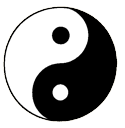
frequently asked questions
What is Chi?
Chi (pronounced chee) is a Chinese word meaning energy, life force or essence that is inherent in everything inanimate or living in the Universe. How Chi (energy) is flowing influences your health, your attitude, your decision-making abilities and your success. The flow of Chi is influenced by factors in the physical environment – the elements, colours, shapes, and orientation – to name just a few. Ideally, we want Chi to flow strongly and without restraint through our entire physical body. In our physical space, we want the Chi to circulate smoothly and freely through every part of the space, filling it with positive energy – some liken this to a gentle babbling brook. Chi (energy) is the essential principle of Feng Shui.
What is the Yin-Yang Theory?
 All things in the Universe have two opposite yet complementary energies – Yin and Yang. Both energy forces are essential. Yin energy represents feminine, passive and dark characteristics of nature. It is calming and relaxing. Too much Yin energy will lower your energy, which could make you feel lethargic. Yang energy represents the masculine, active and bright characteristics. It helps you stay motivated and gives you the push you need to get things done. Too much Yang energy can create chaos and over-stimulation. Feng Shui enables you to balance both the Yin and Yang energies in your environment.
All things in the Universe have two opposite yet complementary energies – Yin and Yang. Both energy forces are essential. Yin energy represents feminine, passive and dark characteristics of nature. It is calming and relaxing. Too much Yin energy will lower your energy, which could make you feel lethargic. Yang energy represents the masculine, active and bright characteristics. It helps you stay motivated and gives you the push you need to get things done. Too much Yang energy can create chaos and over-stimulation. Feng Shui enables you to balance both the Yin and Yang energies in your environment.
What is the Five Elements Theory?
The Five Elements Theory has the same fundamental philosophy as the Yin-Yang Theory – that of continual evolution and balance. Each natural element – wood, fire, earth, metal, and water – has specific attributes that vibrate with their own frequency of energy. In this way, elements interact with each other to affect the energy flow in your environment in a positive or negative manner. Feng Shui Practitioners utilize the concepts of Yin/Yang and the Five Elements to balance competing energies in your environment.
What are the Eight Trigrams?
Trigrams are basic symbols of Eastern philosophy representing transitional phases in nature and in humans. The eight Trigrams represent the maximum number of Yin and Yang relationships in sets of three. Yin and Yang forces are combined as yin/yin; yin/yang; yang/yin; and yang/yang combinations. These four forces are once again divided to form eight trigrams (called the pa kua or bagua) and linked to the forces of nature: Heaven and Earth; Fire and Water; Thunder and Wind; Mountain and Lake. They are associated with a host of natural and human phenomena including seasons, magnetic direction, colours, body parts, related illnesses and numbers. The eight trigrams are the basis to form the 64 hexagrams that make up the I Ching.

